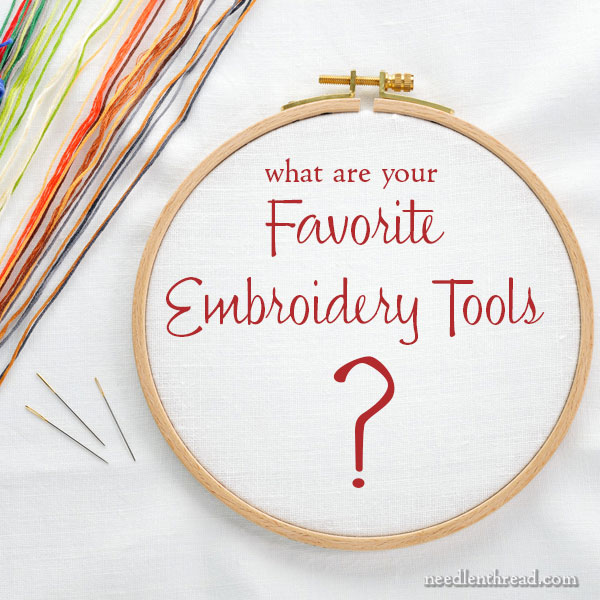March 21, 2015
Needlework News Snips!
Good morning, and a happy Saturday all around!
For your weekend browsing, here are a few snips of needlework related goings-on, online. So, grab a cuppa, and let’s have a browse, shall we?
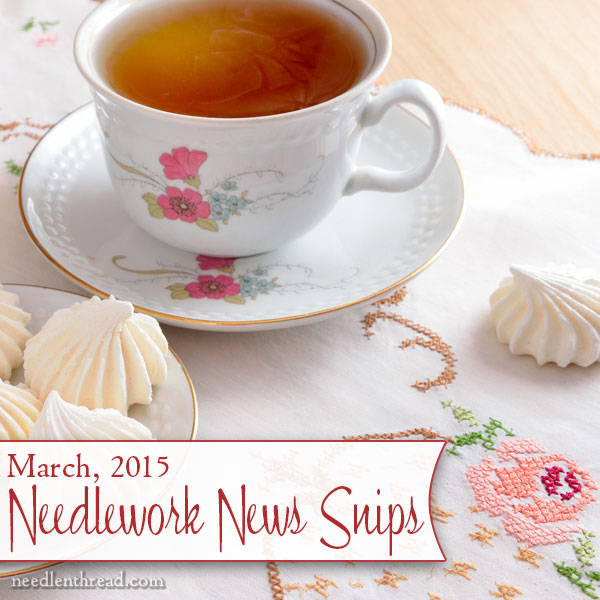
March 21, 2015
Good morning, and a happy Saturday all around!
For your weekend browsing, here are a few snips of needlework related goings-on, online. So, grab a cuppa, and let’s have a browse, shall we?

March 20, 2015
Once upon a time, when I was a kid (ok, back in the late 1900’s – like, 1999 – when I wasn’t really a kid), I came across The A-Z of Bullions on my sister’s bookshelf.
My next-oldest sister has always been My Hero when it comes to churning out arts, crafts, real cooking, and pretty much All Things Handmade. If she turns her hand to something that requires Making, she’s generally successful at it.
Heirloom sewing (this hand embroidered First Communion dress, for example) was one of her first loves. Long before I ever got into real embroidery, she was stitching bullion knots on her children’s clothes.
But then, that’s because she’s So Much Older than I am.
Chortle, chortle.
It’s no wonder, then, that, once upon a time back in 1999, I found the A-Z of Bullions on her bookshelf.
And given my growing infatuation with embroidery, it’s equally no wonder that I absconded with it.
This is the book that taught me how to work bullion knots easily and with confidence.
And it’s one of the many A-Z books that have been recently republished by Search Press, this one under the title of A-Z of Embroidered Motifs.
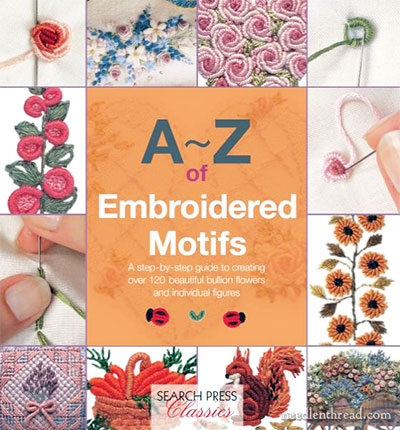
March 19, 2015
You know what the funniest thing is about setting a concrete stitching commitment, with a daily stitching goal attached to it?
You find yourself thinking about the project Every Single Day. Pre-commitment – before I set in concrete my goal to embroider one feather a day on the Secret Garden Hummingbirds – days and days would go by without the project ever entering my brain.
Sure, occasionally, I’d glimpse it, perched on a stand, covered, waiting for attention. But just as quickly as I saw it, out it went again, replaced by some other pressing task.
But now, I have feathers on the brain. I can’t escape them!
On the bright side, it is paying off. In fact, I’ve even put another feather in the bank, so I’m four feathers ahead on my stitching goal.
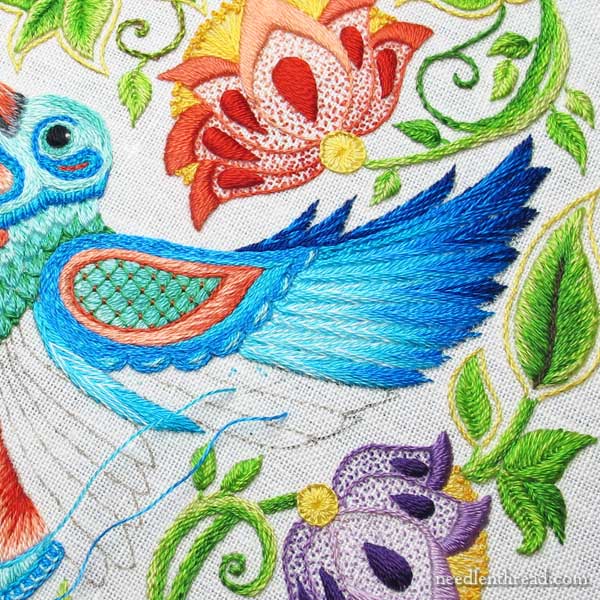
March 18, 2015
Here in Kansas, the rapid onset of spring in the last week is forcing out the buds on flowers, trees and shrubs.
Yeeeehaw! That’s exciting!
To celebrate, I thought I’d share a little Stitch Fun tutorial with you, to show you a simple way to embroider a pretty little floral vine speckled with tiny buds.
This is one of the many combinations in my Stitch Sampler Alphabet (ebook coming soon!), and it’s one of my favorites. It’s quick to work, simple, and very adaptable – think crazy quilt seam treatments, borders, sampler bands, or a floral element in embroidered gardens and landscapes. The combination could also be reasonably adapted into crewel work for wide vines. There are lots and lots of possibilities!
Ready? Here it is – a Stitch Fun tutorial for a floral vine with tiny buds, using up and down buttonhole stitch.
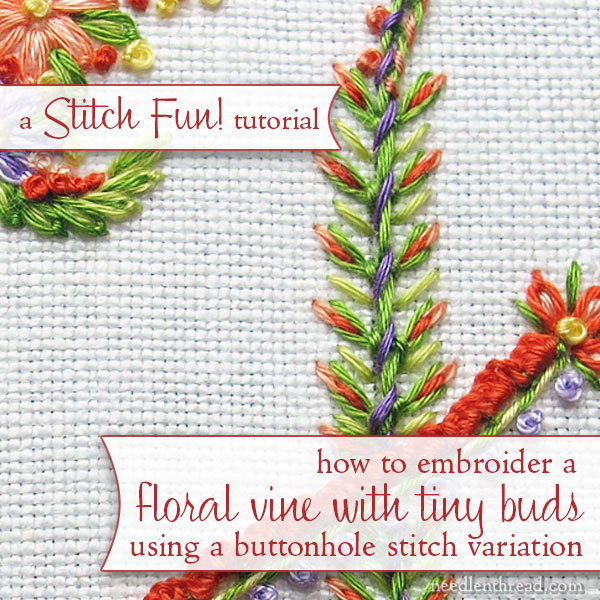
March 17, 2015
Lately, I’ve been exploring embroidered tapestries and other needlework projects that tell stories.
And there are oh, so many of them out there!
Embroidery has been used to tell stories for a long, long time. We’re probably all familiar with the Bayeux Tapestry, a 230-foot long embroidered cloth that relates the tale of the Norman conquest of England in 1066. (If you haven’t seen it, this video animating the Bayeux Tapestry is fun!)
But the Bayeux Tapestry, while certainly the most famous, is not the only embroidered tale worthy of attention.
In recent years, many fascinating tapestry projects that focus on retelling an important story have been undertaken and completed. For example, the Ros Tapestry, which I wrote about previously, retells a snippet of the history of Ireland.
Despite the fact that it’s St. Patrick’s Day and everyone’s thinking Irish, here’s a modern Scottish tapestry that relates a snippet of Scottish history and is definitely worth exploring!
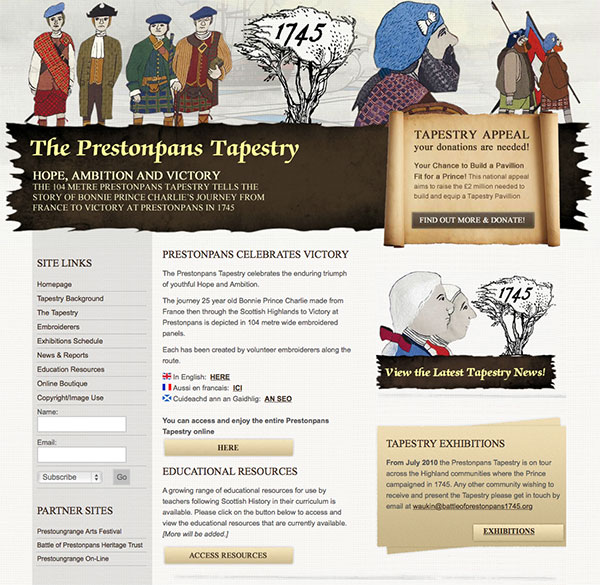
March 16, 2015
Tomorrow’s St. Patrick’s Day, a great reason to celebrate All Things Irish-ish!
To celebrate a day early, I thought I’d show you a wee bit of Irish Inspiration, in the form of a lovely piece of tambour embroidery worked by a reader.
I really love what she did with the this embroidery pattern!
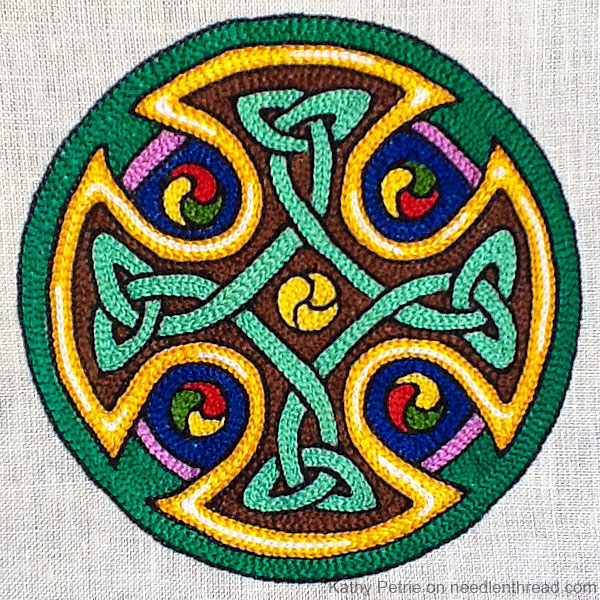
March 14, 2015
The essential tools for hand embroidery are pretty simple: needle, scissors, and a hoop or frame pretty much cover it.
When considering those essential tools, though, no doubt we all have our favorites. We like a certain type of hoop or frame; we have our favorite pair of scissors; and there are certain brands of needles that we gravitate towards, because we know they’re reliable.
Chances are, along our different needlework journeys, we’ve also acquired other tools that we’ve become attached to – tools that go beyond the basics, but that make our stitching lives a bit easier or perhaps just more pleasurable.
So that we can collectively help each other – and especially help stitchers new the art and craft of embroidery – I’d like to find out what your favorite tools are and why. I’ll recap some of mine below, and then ask you to tell us about yours.
